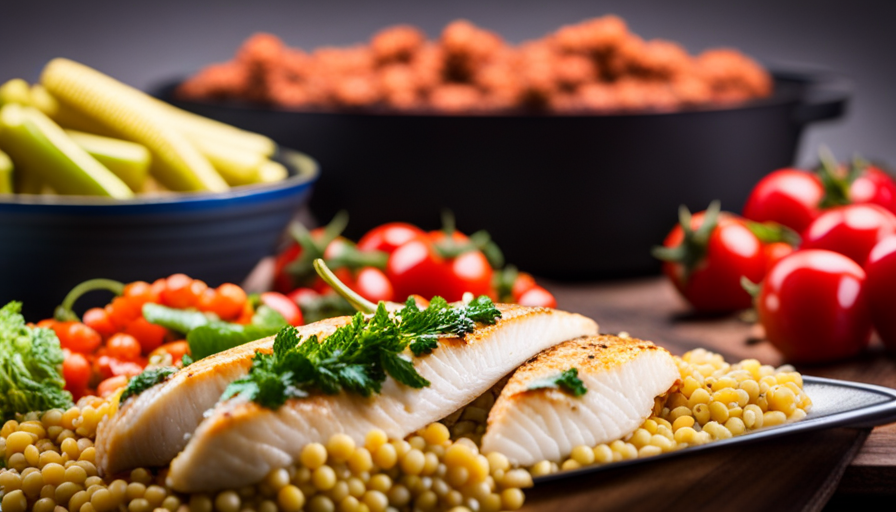Think of your body as a highly efficient machine that continuously works to keep you energized, focused, and healthy. Now, envision supplying that machine with the purest, most natural form of nourishment – raw food.
Just like a high-performance car runs smoother and more efficiently with premium fuel, your body thrives on the power of raw food.
Switching to a raw food diet is like hitting the reset button on your health. By consuming unprocessed, uncooked foods, you provide your body with an abundance of nutrients, enzymes, and antioxidants that are often lost during cooking.
This transformation can have a profound impact on how you feel both physically and mentally. From increased energy levels and improved digestion to weight loss and enhanced mental clarity, the benefits of a raw food diet are numerous.
Not only does it strengthen your immune system and reduce inflammation, but it also promotes better sleep and allows for increased nutrient intake.
In this article, we will explore the incredible effects of transitioning to a raw food diet and how it can revolutionize the way you feel. Get ready to experience a whole new level of vitality and well-being, one bite at a time.
Key Takeaways
- Switching to a raw food diet can lead to increased energy levels and improved mental clarity.
- A raw food diet promotes a healthy gut microbiome and improves digestion.
- Consuming raw fruits and vegetables fortifies the immune system and enhances overall well-being.
- Following a raw food diet can result in clearer skin, healthier hair, and reduced inflammation and joint pain.
Increased Energy Levels
You’ll feel a surge of energy coursing through your veins on a raw food diet, giving you the stamina to conquer any challenge that comes your way. The increased productivity and boosted mood that comes with this change in diet is undeniable.
When we consume raw, unprocessed foods, our bodies are able to extract maximum nutrients, vitamins, and minerals, which directly translates into increased energy levels. This is because raw foods are rich in enzymes that aid in digestion and absorption, allowing our bodies to efficiently convert food into energy. Additionally, raw foods are packed with antioxidants that fight off free radicals and reduce inflammation, further contributing to our overall energy levels.
As our energy levels increase, so does our ability to tackle tasks and accomplish goals. With heightened productivity, we are able to complete projects more efficiently and with greater focus. This not only benefits our professional lives, but it also spills over into our personal lives, enhancing our relationships and overall sense of fulfillment.
Furthermore, the boosted mood that accompanies a raw food diet can have a profound impact on our well-being. When we feel energized and content, it positively affects our mental state, leading to increased motivation and a more positive outlook on life.
Transitioning into the subsequent section about improved digestion and gut health, the benefits of a raw food diet extend beyond just increased energy levels.
Improved Digestion and Gut Health
Your digestive system will experience significant enhancements and a healthier gut as a result of this dietary adjustment. The raw food diet is rich in fiber, which aids in maintaining a healthy gut microbiome. This means that the beneficial bacteria in your gut will thrive, leading to improved digestion and overall gut health.
Additionally, raw fruits and vegetables are packed with digestive enzymes that can help break down food more efficiently, reducing the strain on your digestive system. These enzymes also assist in the absorption of nutrients, ensuring that your body gets the most out of the food you consume.
-
Increased fiber intake promotes regular bowel movements, preventing constipation and supporting a healthy gut.
-
The abundance of beneficial bacteria in the gut microbiome can strengthen the immune system and reduce the risk of digestive disorders.
-
Digestive enzymes found in raw foods aid in the breakdown of proteins, fats, and carbohydrates, promoting efficient digestion and nutrient absorption.
Transitioning to a raw food diet not only improves digestion and gut health but also contributes to weight loss and maintenance.
Weight Loss and Maintenance
By incorporating a variety of vibrant, nutrient-dense fruits and vegetables into your meals, shedding excess pounds and keeping them off becomes easier. The raw food diet is known for its ability to promote weight loss and help with weight maintenance. When you consume raw, unprocessed foods, you naturally consume fewer calories while still providing your body with essential vitamins, minerals, and fiber. This can lead to a gradual and sustainable weight loss.
In addition to the calorie control aspect of the raw food diet, the high fiber content of fruits and vegetables helps to keep you feeling fuller for longer, reducing the temptation to snack on unhealthy foods. Healthy recipes and meal planning play a crucial role in ensuring that you have a balanced and satisfying raw food diet. By incorporating a variety of fruits, vegetables, nuts, and seeds into your meals, you can create delicious and nutritious dishes that support your weight loss goals.
Table:
| Raw Food Recipes | Meal Planning | Weight Loss Tips |
|---|---|---|
| Green Smoothie | Weekly Meal | Portion Control |
| Salad | Prep | Mindful Eating |
| Zucchini Noodles | Grocery List | Regular Exercise |
As you transition into the next section about enhanced mental clarity and focus, it’s important to note that the raw food diet not only helps with weight loss but also provides numerous other health benefits.
Enhanced Mental Clarity and Focus
Indulging in a colorful array of nutrient-rich fruits and vegetables can unlock a mental clarity and focus that transports you to a world of vibrant thoughts and laser-like concentration. The raw food diet isn’t just about weight loss; it also offers numerous benefits for your brain.
Studies have shown that consuming a diet high in raw foods can improve cognitive function and increase productivity. Raw fruits and vegetables are packed with essential nutrients that promote brain health and enhance mental clarity. They’re rich in antioxidants, vitamins, and minerals that support optimal brain function. These nutrients help protect the brain from oxidative stress and inflammation, which can negatively impact cognitive abilities.
Additionally, the raw food diet provides a steady supply of energy to the brain. Raw foods are easily digestible and provide a consistent source of glucose, the brain’s primary fuel. This steady energy supply helps maintain focus and concentration throughout the day.
Furthermore, the raw food diet promotes a healthy gut microbiome, which plays a crucial role in brain health. The gut and brain are interconnected through a complex network of nerves and chemicals, known as the gut-brain axis. A balanced gut microbiome positively influences cognitive function and mood.
Incorporating more raw foods into your diet can lead to improved cognitive function and increased productivity. The mental clarity and focus gained from this dietary change can help you excel in both personal and professional endeavors.
As we delve into the next section about a stronger immune system, it’s important to recognize the interconnectedness of our bodily systems and how they contribute to overall well-being.
Stronger Immune System
Nourishing your body with a vibrant array of nutrient-rich fruits and vegetables can fortify your immune system, creating a shield of protection against illness and enhancing your overall well-being. A strong immune system is crucial for fighting off illness and keeping our bodies healthy. When we follow a raw food diet, we provide our bodies with an abundance of vitamins, minerals, and antioxidants that are essential for boosting immunity.
The table below illustrates three key nutrients found in raw fruits and vegetables that can help strengthen our immune system:
| Nutrient | Function | Food Sources |
|---|---|---|
| Vitamin C | Boosts immune response | Citrus fruits, kiwi, peppers |
| Beta-carotene | Enhances immune function | Carrots, sweet potatoes, spinach |
| Zinc | Supports immune system | Pumpkin seeds, lentils, cashews |
By consuming these nutrient-dense foods, we can enhance our body’s ability to fight off infections and stay healthy. A stronger immune system not only helps us avoid common illnesses like colds and flu but also contributes to our overall well-being.
As we continue on the raw food diet journey, we will discover the additional benefits it brings, such as clearer skin and healthier hair. These outcomes are closely tied to the nutrients we consume and the overall health of our bodies.
Clearer Skin and Healthier Hair
Consuming a variety of nutrient-rich fruits and vegetables on a raw food diet can lead to clearer skin and healthier hair. When we provide our bodies with the essential vitamins, minerals, and antioxidants found in raw foods, we nourish our skin and hair from within.
Clear skin is often a result of a healthy diet, and raw foods can play a significant role in achieving this. The abundance of vitamins A and C found in fruits and vegetables helps to promote collagen production, which keeps our skin firm and youthful. Additionally, these foods are rich in antioxidants that fight off free radicals, reducing skin damage and inflammation. This can result in a more even complexion and a reduction in acne breakouts.
Furthermore, the nutrients present in raw foods can contribute to hair health and shine. Vitamin C, for example, aids in the production of collagen, which is essential for maintaining strong and healthy hair. Additionally, the vitamins and minerals found in raw fruits and vegetables support the production of sebum, the natural oil that keeps our hair moisturized and shiny.
Transitioning into the subsequent section about ‘reduced inflammation and joint pain,’ the benefits of a raw food diet extend beyond clear skin and healthier hair.
Reduced Inflammation and Joint Pain
Say goodbye to those achy joints and inflammation by incorporating more nutrient-rich fruits and vegetables into your daily meals – your body’ll thank you for the soothing relief! The raw food diet’s been shown to reduce inflammation and joint pain, leading to improved overall health and well-being. Here are five ways that this diet change can help alleviate your discomfort:
-
Decreased swelling: The natural antioxidants found in raw fruits and vegetables help to reduce inflammation in the body, leading to decreased swelling in the joints.
-
Enhanced mobility: By reducing inflammation, the raw food diet can improve joint function, allowing for increased mobility and flexibility.
-
Pain relief: Many individuals experience a decrease in joint pain after adopting a raw food diet, as the nutrient-rich foods provide the body with the necessary tools to repair and rejuvenate damaged tissues.
-
Increased energy levels: As inflammation decreases, energy levels tend to rise, allowing for a more active and pain-free lifestyle.
-
Improved quality of life: By reducing inflammation and joint pain, the raw food diet can greatly improve one’s overall quality of life, enabling individuals to engage in activities they may’ve previously avoided.
By incorporating more raw fruits and vegetables into your diet, you can experience the benefits of reduced inflammation and joint pain. Additionally, this diet change can also lead to improved sleep quality, which we’ll discuss in the next section.
Improved Sleep Quality
Get ready for a restful night’s sleep with improved sleep quality that will leave you feeling refreshed and revitalized. When you switch to a raw food diet, you may notice a significant improvement in your sleep patterns. Research has shown that consuming raw foods can have a positive impact on sleep quality, leading to better concentration and reduced stress levels.
To understand how a raw food diet can improve sleep, let’s take a look at the following table:
| Raw Food Diet and Improved Sleep Quality | |
|---|---|
| More fruits and vegetables | Rich in nutrients that promote sleep, such as magnesium and potassium |
| Reduced intake of processed foods | Less likely to disrupt sleep patterns |
| Increased hydration | Hydrated body promotes better sleep |
| Balanced blood sugar levels | Stable blood sugar levels prevent sleep disturbances |
By incorporating more raw fruits and vegetables into your diet, you provide your body with essential nutrients that promote better sleep. Additionally, avoiding processed foods helps prevent sleep disruptions that can occur due to additives and preservatives. Staying hydrated and maintaining balanced blood sugar levels also contribute to a good night’s sleep.
Improved sleep quality is just one of the many benefits of a raw food diet. In the next section, we will explore how this diet change can lead to increased nutrient intake.
Increased Nutrient Intake
Imagine how your body would benefit from a higher intake of essential nutrients found in raw fruits and vegetables, like vitamin C and fiber. This can boost your immune system and improve digestion, leading to increased energy levels and overall well-being.
Incorporating a raw food diet into your lifestyle can significantly increase your nutrient intake, providing numerous health benefits. Here are five ways that an increased intake of raw fruits and vegetables can enhance your vitality and improve your overall health:
-
Enhanced immune system: Raw foods are packed with vitamins, minerals, and antioxidants that strengthen your immune system, helping you fight off illnesses and infections more effectively.
-
Improved digestion: The high fiber content in raw fruits and vegetables aids in digestion, preventing constipation and promoting regular bowel movements.
-
Increased energy levels: Raw foods are rich in natural sugars and complex carbohydrates that provide a sustained release of energy, keeping you energized throughout the day.
-
Weight management: A raw food diet is naturally low in calories and high in fiber, promoting weight loss and helping you maintain a healthy weight.
-
Improved skin health: The vitamins and antioxidants in raw fruits and vegetables can improve the appearance of your skin, giving it a healthy glow and reducing the signs of aging.
By increasing your nutrient intake through a raw food diet, you can experience increased vitality and improved overall health. As we transition into the next section about environmental and ethical considerations, it’s important to consider the impact of our food choices on the planet and animal welfare.
Environmental and Ethical Considerations
Since transitioning to a raw food diet and experiencing the benefits of increased nutrient intake, I have also become more aware of the environmental and ethical considerations associated with my food choices. The raw food diet emphasizes the consumption of fruits, vegetables, nuts, and seeds in their natural, unprocessed state, which has a lower environmental impact compared to conventional diets.
By choosing to eat raw, I am reducing my carbon footprint and supporting sustainable farming practices. This is because raw foods require less energy and resources to produce and transport compared to processed foods. Additionally, the raw food diet promotes the consumption of organic, locally sourced produce, which further minimizes the environmental impact associated with pesticide use and long-distance transportation.
Moreover, the raw food diet aligns with my concern for animal welfare. By focusing on plant-based foods, I am reducing my support for factory farming and the cruelty often associated with it. Animals raised for meat, dairy, and eggs in industrialized farming systems are often subjected to cramped living conditions, routine antibiotic use, and inhumane slaughter practices. Choosing a raw, plant-based diet allows me to contribute to the well-being of animals and promote their ethical treatment.
| Environmental Impact | Animal Welfare |
|---|---|
| Reduced carbon footprint | Support for cruelty-free practices |
| Sustainable farming practices | Reduction in factory farming |
| Organic, locally sourced produce | Promotion of ethical treatment of animals |
Frequently Asked Questions
Are there any potential side effects or risks associated with transitioning to a raw food diet?
There are potential side effects and risks associated with transitioning to a raw food diet. Some people may experience digestive issues such as bloating, gas, and diarrhea due to the increased fiber intake.
There is also a risk of nutrient deficiencies, particularly in vitamin B12, iron, and calcium. It’s important to carefully plan a raw food diet to ensure adequate nutrient intake.
Consulting with a healthcare professional or registered dietitian can help minimize these risks and ensure a healthy transition.
Can a raw food diet provide all the necessary nutrients for optimal health?
A raw food diet can provide all the necessary nutrients for optimal health. For example, a study conducted on individuals following a raw food diet found that their nutrient intake met or exceeded the recommended daily allowances for most nutrients.
Raw food benefits include higher nutrient content, increased fiber intake, and improved digestion. Additionally, there are numerous delicious raw food recipes available that can help ensure a balanced and nutritious diet.
How can I maintain a raw food diet while dining out or attending social events?
To maintain a raw food diet while dining out or attending social events, there are a few strategies you can follow.
First, research restaurants in advance to find ones that offer raw food options.
When dining out, opt for salads, fresh fruits, and vegetable-based dishes.
At social events, bring your own raw food snacks or eat before you go.
It’s also helpful to communicate your dietary preferences to friends and family, so they can accommodate your needs.
With careful planning and communication, it’s possible to stick to a raw food diet even in social settings.
Are there any specific foods or ingredients that should be avoided on a raw food diet?
There are certain foods and ingredients that should be avoided on a raw food diet. Some common challenges include avoiding processed foods, which are often high in preservatives, additives, and unhealthy fats. It’s also important to steer clear of refined sugars and flours, as they can negatively impact your health.
Additionally, it’s recommended to avoid foods that have been cooked at high temperatures, as this can destroy the enzymes and nutrients present in raw foods.
Can a raw food diet be suitable for individuals with certain health conditions or dietary restrictions?
A raw food diet can be suitable for individuals with certain health conditions or dietary restrictions, such as weight loss or diabetes management. Studies have shown that a raw food diet can lead to weight loss due to its high fiber content and low energy density.
Additionally, the consumption of raw fruits and vegetables in a raw food diet can help regulate blood sugar levels, making it beneficial for individuals with diabetes. However, it’s important to consult with a healthcare professional before starting any new diet or making significant dietary changes.
What Are the Benefits of a Raw Food Diet and How Does It Affect How You Feel?
The benefits of a raw food diet are numerous, including improved digestion, increased energy, and better overall health. Raw food preservation methods such as dehydration or fermentation help retain vital nutrients and enzymes in food, leading to a positive impact on how you feel, both physically and mentally.
Conclusion
In conclusion, my experience with switching to a raw food diet has been life-changing. Not only have I noticed increased energy levels and improved digestion, but I’ve also lost weight and successfully maintained it. The mental clarity and focus I now have is remarkable, and my immune system feels stronger than ever.
Additionally, the reduction in inflammation and joint pain has been a game-changer for me. I’m sleeping better and know that I’m getting a higher intake of essential nutrients.
Lastly, the environmental and ethical considerations of this diet have made me feel even more connected to the world around me. Overall, I highly recommend exploring the benefits of a raw food diet for a healthier and more fulfilling lifestyle.

















